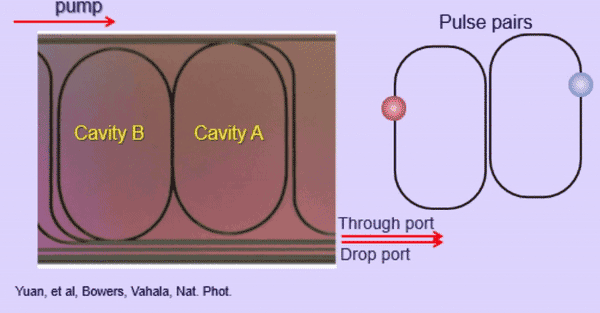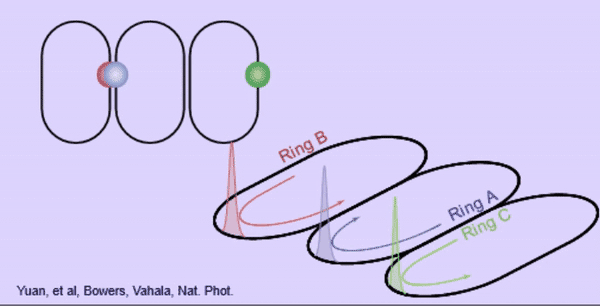Generation of soliton pulse pairs in coupled two- and three-ring microresonators. a, Schematic showing coherent pulse pairs that form a composite excitation. The inset is a photomicrograph of the two-coupled ring resonator used in the experiments. Rings A and B are indicated. Scale bar, 1 mm. b, Simultaneous measurements of optical spectra collected from the pass (pump port) and drop ports in the coupled ring resonator of a. The measured modal dispersion is also plotted. Two dispersive waves are observed at spectral locations corresponding to the phase-matching condition, as indicated by the dispersion curve. c, radio frequency spectrum of the beatnote microcomb. RBW, resolution bandwidth. d, Illustration of the generation of three pulses in a three-ring coupled microresonator in which the pulses pair alternately. The inset is a photomicrograph of the three-coupled ring microresonator used in the experiments. Scale bar, 1 mm. e, Optical spectrum measurement of the three-pulse microcomb. The measured modal dispersion is also plotted. f, Radio frequency spectrum of the microcomb beatnote. Credit: Natural photonics (2023). DOI: 10.1038/s41566-023-01257-2
When we last visited with Caltech’s Kerry Vahala three years ago, his lab had recently reported the development of a new optical device called a turnkey frequency microcomb that has applications in digital communications, precision timekeeping, spectroscopy and even astronomy.
This device, fabricated on a silicon wafer, takes input laser light of one frequency and converts it into a uniformly spaced array of many distinct frequencies that form a train of pulses whose duration can be as short as 100 femtoseconds (quadrillionths of a second). (The comb in the name comes from the fact that the frequencies are spaced like the teeth of a hair comb.)
Now, Vahala, the Ted and Ginger Jenkins Professor of Information Science and Technology and Applied Physics at Caltech and managing director of Applied Physics and Materials Science, along with members of his research group and the group of John Bowers at UC Santa Barbara made a breakthrough in how short pulses form in an important new material called ultra-low loss silicon nitride (ULL nitride), a compound formed of silicon and nitrogen. Silicon nitride is prepared to be extremely pure and deposited in a thin layer.
In principle, short-pulse microcomb devices made from this material would require very low power to operate. Unfortunately, short pulses of light (called solitons) cannot be generated properly in this material due to a property called dispersion, which causes light or other electromagnetic waves to travel at different speeds, depending on their frequency. ULL has what is called normal dispersion, which prevents waveguides made of ULL nitride from supporting the short pulses necessary for the microcomb to operate.
In an article published in Natural photonics, researchers discuss their development of the new microcomb, which overcomes the optical limitations inherent in ULL nitride by generating pulses in pairs. This is an important development because ULL nitride is created with the same technology used to make computer chips. This type of manufacturing technique means that these microcombs could one day be integrated into a wide variety of wearable devices similar in shape to smartphones.
The most distinctive feature of a regular microcomb is a small optical loop that looks a bit like a small running track. During operation, solitons automatically form and circulate around it.
“However, when this loop is made of ULL nitride, the dispersion destabilizes the soliton pulses,” says co-author Zhiquan Yuan, a graduate student in applied physics.
Think of the loop as a race track with cars. If some cars are going faster and others slower, they will spread out as they circle the track instead of staying in a tight group. Similarly, normal ULL dispersion means that the light pulses propagate through the microcomb waveguides and the microcomb stops working.

In this animated gif, optical pulses (solitons) can be seen rotating through joint optical tracks. Credit: Yuam, Bowers, Vahala et al.
The solution the team came up with was to create several circuits, combining them to look a bit like a figure eight. In the middle of this ‘8’, the two pieces are parallel to each other with only a small gap between them.
If we continue with the racetrack analogy, it would be like two tracks sharing one from the start. As cars from each lane converge on this shared section, they encounter something that resembles a traffic jam. Just as two lanes of traffic merging into one on a highway force cars to slow down, the joint section of the two microcombs forces the paired laser pulses to come together. This grouping counters the tendency of pulses to spread out and allows the microcombs to function properly.
“In effect, this counteracts normal dispersion and gives the overall composite system the equivalent of anomalous dispersion,” says graduate student and co-author Maodong Gao.
The idea expands when adding even more racetracks, and the team showed how three racetracks would work equally well by creating two sets of pulse pairs. Vahala believes the phenomenon will continue to work even with many coupled racetracks (microcombs), providing a way to create large arrays of photonic circuits for soliton pulses.

The new microcomb devices, which work like pairs of joined optical tracks, also work when larger numbers are combined. Credit: Yuam, Bowers, Vahala et al.
As noted above, these ULL microcombs are made with the same equipment used to make computer chips based on complementary metal-oxide-semiconductor (CMOS) technology. Bowers, professor of electrical and computer engineering, collaborated on the research and notes that “the manufacturing scalability of the CMOS process means that it will now be easier and more economical to manufacture short-pulse microcombs and integrate them into existing technologies and applications. “.
Regarding these applications, Vahala says “a comb is like a Swiss army knife for optics. It has many different functions, and that’s why it’s such a powerful tool.”
The paper describing the research, “Multicolor Soliton Pulse Pairs in Normal Dispersion Microresonators,” appears in the November issue of Natural photonics.
More information:
Zhiquan Yuan et al, Multi-color Soliton pulse pairs in normal dispersion microresonators, Natural photonics (2023). DOI: 10.1038/s41566-023-01257-2
Provided by California Institute of Technology
Quote: Joint “racetracks” make possible a new optical device (December 8, 2023) retrieved December 9, 2023 from
This document is subject to copyright. Except for fair use for private study or research purposes, no part may be reproduced without written permission. The content is provided for information only.



